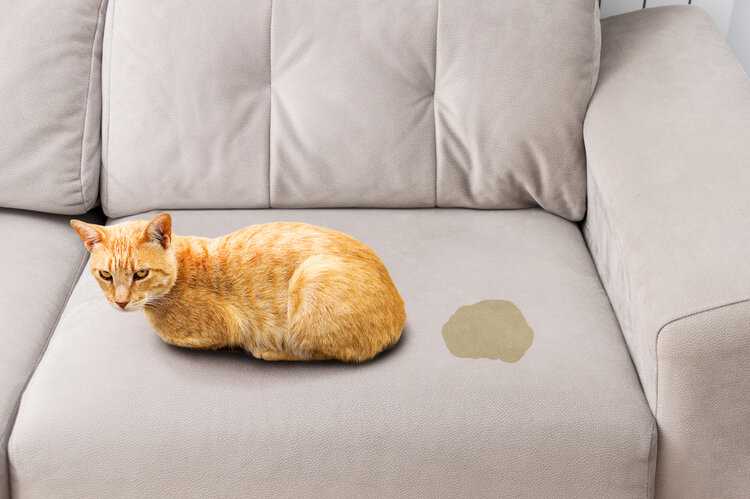



Start with white vinegar mixed with water in a spray bottle. This solution neutralizes unpleasant scents effectively. Apply it generously to the affected area, allowing it to sit for about 10-15 minutes.
Next, blot the fabric with a clean, absorbent cloth. Avoid rubbing the material, as this can push the liquid deeper into the fibers. Focus on dabbing the area until the cloth comes away mostly dry.
For persistent odors, a sprinkle of baking soda over the damp area can work wonders. Let it sit for several hours or overnight to absorb any remaining smells. Vacuum the baking soda afterward to reveal a fresher surface.
If the fabric allows, a gentle wash using a fabric-safe detergent can be beneficial. Always check care labels first to ensure that the material can withstand washing. Air dry completely to prevent any lingering scents.
Steps to Remove Feline Markings from Upholstery
First, gather white vinegar, baking soda, and a clean cloth. Blot the affected area with a cloth to absorb excess moisture. Mix equal parts water and vinegar in a spray bottle, then apply to the stained region.
After 5-10 minutes, blot again with a dry cloth. Sprinkle baking soda over the area and let it sit for several hours or overnight. Vacuum the residue thoroughly afterward.
Odor Neutralization Technique
If lingering scents remain, create a solution of hydrogen peroxide and dish soap (test on a small area first). Apply it gently, let it sit, and then blot. Using an enzyme cleaner specifically designed for organic stains can effectively eliminate odors.
Final Touches
After treatment, allow the area to dry completely. Open windows or use a fan to improve airflow. Regular maintenance helps prevent future incidents.
Identify the Source and Assess the Damage

First, locate the exact area where the mishap happened. Follow your nose; the scent will guide you to the origin. Pay attention to any darkened spots or discoloration on the fabric, as these often indicate the affected regions.
Next, evaluate the extent of the issue:
- Check if the liquid has penetrated through the fabric and into the foam. A simple touch test can help; if the foam feels damp, further action is necessary.
- Inspect surrounding areas for any additional incidents. Cats can sometimes leave multiple surprises.
- Consider the age of the stain. Fresh marks are generally easier to manage compared to older ones that may have set in.
Taking these steps will provide a clearer picture of the situation and guide the next actions effectively.
Gather Necessary Cleaning Supplies

Start with paper towels or absorbent cloths to soak up the liquid. These are crucial for initial blotting to reduce moisture. Grab a spray bottle for mixing solutions easily. An enzyme-based cleaner is a must-have; it breaks down the odor-causing compounds effectively. A mixture of water and white vinegar can also serve as a natural alternative. Keep baking soda handy for deodorizing after treatment. A soft brush or cloth will aid in scrubbing, while gloves protect your paws from any harsh chemicals. Lastly, a vacuum can help in the final cleanup, ensuring no residue remains.
Apply a Homemade Enzyme Cleaner
Mix one cup of warm water, one cup of white vinegar, and two tablespoons of baking soda in a spray bottle. Shake gently until the ingredients combine without excessive foam.
Spray the mixture generously onto the affected areas. Allow it to sit for at least 15 minutes to enable the enzymes to break down the odor-causing substances.
Use a clean cloth or paper towel to blot, absorbing the moisture. Repeat this process as necessary until the scent dissipates completely.
Final Rinse
After treating the spot, dampen a cloth with plain water and blot the area again to remove any residue from the cleaning solution. This step ensures no lingering odors or stickiness remains. Let it air dry thoroughly.
Prevention Tips
Consider using a protective cover on furniture to prevent future accidents. Regularly check for any signs of mishaps to address them promptly.
Blot and Rinse the Affected Area
Immediately tackle the spot with a clean cloth or paper towel. Gently press down to absorb as much liquid as possible. Avoid rubbing, as it can spread the mess further into the fabric. Once the majority is absorbed, rinse the area with cold water, ensuring the cloth remains damp but not soaked. This helps to dilute any remaining residue.
For stubborn stains, consider repeating the blotting and rinsing process. It’s important to keep the fabric moist without over-saturating it, as excessive water can lead to mold or mildew beneath the surface.
After rinsing, let the area air dry completely. If an odor persists, applying a homemade enzyme cleaner will eliminate lingering smells effectively. Remember to keep the surroundings comfortable, perhaps with a best calming bed for cats to ensure a stress-free environment.
| Step | Action |
|---|---|
| 1 | Blot the area with a clean cloth |
| 2 | Rinse with cold water |
| 3 | Allow to air dry completely |
Use Baking Soda for Odor Neutralization
Sprinkle a generous layer of baking soda directly onto the affected area. This natural powder absorbs unpleasant smells effectively. Let it sit for at least 15 minutes, or even longer for stubborn odors. The longer it remains, the better the results. Afterward, vacuum the baking soda thoroughly. This not only removes the powder but also helps lift any remaining particles that may be causing an odor.
For enhanced results, consider mixing baking soda with a few drops of essential oil. This can add a pleasant scent while still neutralizing unwanted odors. Be cautious with the amount of oil used; a few drops will suffice. Ensure that any essential oil chosen is safe for pets before application.
Baking soda is a simple yet powerful remedy. Using it regularly can keep your furniture smelling fresh and clean. This method is safe and non-toxic, making it ideal for homes shared with furry friends.
Ensure Proper Drying and Maintenance Tips
After treating the stained area, ensuring thorough drying is crucial. Use a fan or dehumidifier to speed up the process. Proper airflow prevents mold and mildew growth.
Regular Maintenance
Regular vacuuming and spot cleaning contribute to a clean environment. Consider using a quality best portable pcp air compressor to remove dirt and trapped debris from fabric. This helps maintain freshness.
Protective Measures
Utilize slipcovers or waterproof barriers to minimize damage from potential accidents. This proactive approach saves time and effort in future clean-ups. Frequent inspections can help identify any issues early, ensuring longevity of furniture.
FAQ:
What is the first step to take when cleaning cat urine from couch cushions?
The first step in cleaning cat urine from couch cushions is to act quickly. Blot the affected area with paper towels or a clean cloth to absorb as much of the urine as possible. Avoid rubbing, as this can push the urine deeper into the fabric. It’s important to work from the outside of the stain toward the center to prevent spreading. Once you’ve absorbed the liquid, you can move on to using a cleaning solution.
What homemade solutions can be used to eliminate the odor from cat urine?
A popular homemade solution for eliminating cat urine odor includes a mixture of white vinegar and water. Combine equal parts of white vinegar and water in a spray bottle and apply it to the stained area. Let it sit for about 10-15 minutes before blotting it dry with a clean cloth. This mixture helps neutralize the odor. Another option is to use baking soda. After applying the vinegar solution and letting it dry, sprinkle baking soda over the area and vacuum it up after a few hours. This will further help absorb any lingering smells.
Are there any commercial products recommended for cleaning cat urine from couch cushions?
Yes, there are several commercial products specifically designed for cleaning pet urine. Look for enzymatic cleaners, as they break down the components of urine, effectively eliminating odors and stains. Brands like Nature’s Miracle or Rocco & Roxie are often recommended. Follow the instructions on the product label for the best results. It’s advisable to test the cleaner on a small, inconspicuous area of the couch cushion first to ensure it doesn’t damage the fabric. After applying the cleaner, make sure to allow it to sit for the recommended time before blotting or rinsing.








